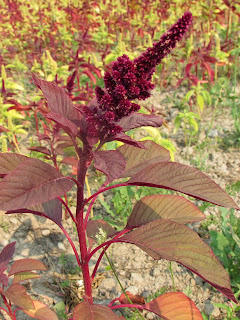Have you started growing amaranth yet? If you visit the little field you will see this beautiful plant that can grow up to 8 feet high, making it both a lovely ornamental plant and excellent nutritional source of gluten-free food. Like quinoa, amaranth is not technically a grain but is the seed. One plant can produce up to 60,000 seeds.
Amaranth was a key part of the diets of the pre-Columbian Aztecs, and it was used both for food and as part of their religious ceremonies. Sadly, when Cortez and the Spanish conquistadors arrived in the 16th century, amaranth crops were burned and its use forbidden.
Amaranth has a protein content of about 13%, which is much higher than most other grains. It has twice as much protein as a cup of long-grain rice (26 grams of protein in one cup). It also contains lysine, making it a complete protein containing all of the essential amino acids.
It is a source of key vitamins and minerals - calcium, magnesium, potassium, phosphorus, and iron. One cup of uncooked amaranth has 31% of the recommended dietary allowance of calcium, 14 percent for vitamin C, and a whopping 82 percent for iron.
Amaranthus, collectively known as amaranth, is a cosmopolitan genus of annual or short-lived perennial plants. Some amaranth species are cultivated as leaf vegetables, cereals, and ornamental plants. Most of the Amaranthus species are summer annual weeds and are commonly referred to as pigweed.
This plant is hardy, preferring a high elevation, but can grow at almost any elevation in temperate climates if it has moist, loose soil with good drainage. It can also survive in low-water conditions once the plants have been established. Considered a native plant of Peru, it is now grown around the world in countries including China, Russia, Thailand, Nigeria, Canada, the US, and Mexico, and has become a part of the cuisines of India, Nepal and the African continent.
More than 60 different species exist of this super food. The leaves of the amaranth plant are also edible. Commonly used in Asian and Caribbean cuisines, they can be stir-fried or chopped and added to soup. Amaranth porridge is a traditional breakfast in Peru, India, Mexico and Nepal. Popped amaranth is used in Mexico as a topping for toast that looks like tiny popcorn kernels and has a nutty taste.
It has been estimated that amaranth was first domesticated 6,000 to 8,000 years ago - and considering how easily and quickly it grows, that makes sense!
Amaranth is good for your heart - several studies have shown that amaranth could have cholesterol-lowering potential. For example, a 2003 study published in Guelph showed that amaranth has phytosterols, which have cholesterol-cutting properties.
Among its other impressive nutritional stats, amaranth is a good source of fibre, with 13 grams of dietary fibre per uncooked cup compared to 2 grams found in long-grain white rice.
In my next post I will explore some more of the history of this fascinating plant and how it was used by the indigenous peoples of the Americas.













